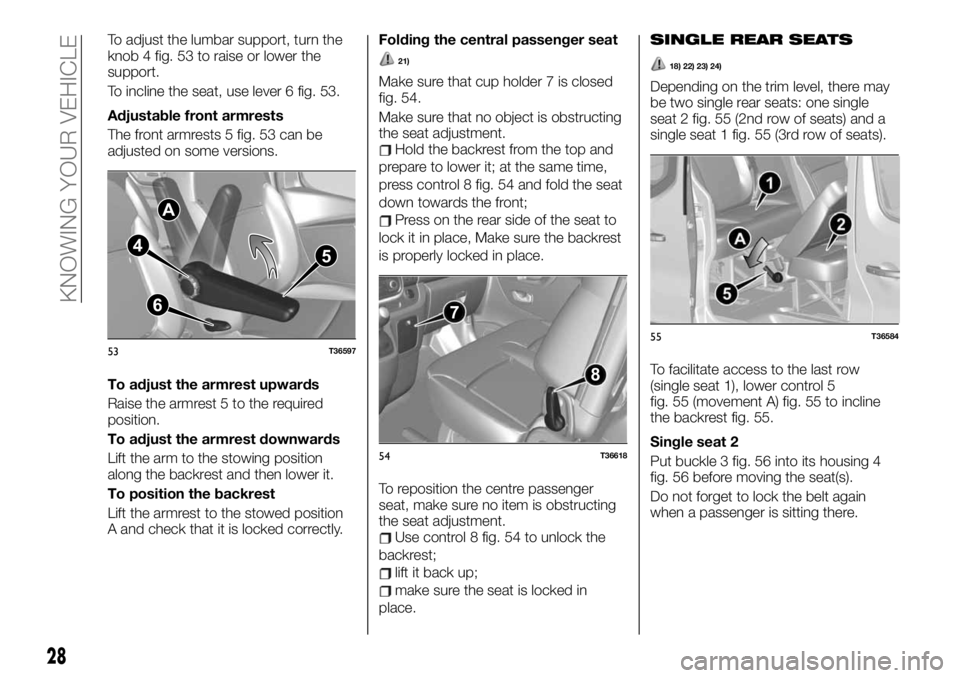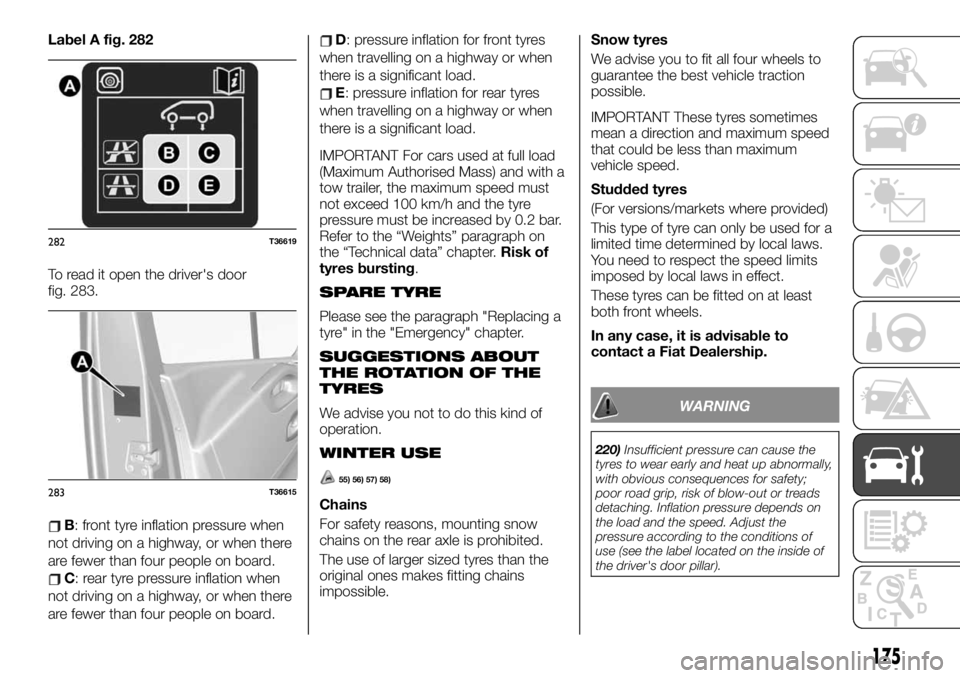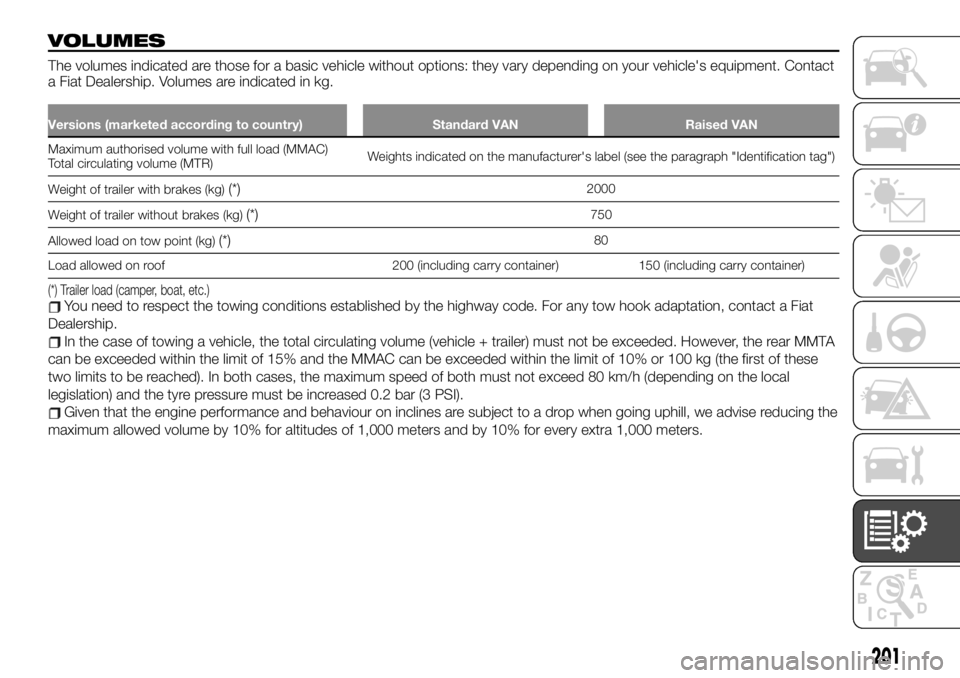tow bar FIAT TALENTO 2021 Owner handbook (in English)
[x] Cancel search | Manufacturer: FIAT, Model Year: 2021, Model line: TALENTO, Model: FIAT TALENTO 2021Pages: 236, PDF Size: 4.86 MB
Page 30 of 236

To adjust the lumbar support, turn the
knob 4 fig. 53 to raise or lower the
support.
To incline the seat, use lever 6 fig. 53.
Adjustable front armrests
The front armrests 5 fig. 53 can be
adjusted on some versions.
To adjust the armrest upwards
Raise the armrest 5 to the required
position.
To adjust the armrest downwards
Lift the arm to the stowing position
along the backrest and then lower it.
To position the backrest
Lift the armrest to the stowed position
A and check that it is locked correctly.Folding the central passenger seat
21)
Make sure that cup holder 7 is closed
fig. 54.
Make sure that no object is obstructing
the seat adjustment.
Hold the backrest from the top and
prepare to lower it; at the same time,
press control 8 fig. 54 and fold the seat
down towards the front;
Press on the rear side of the seat to
lock it in place, Make sure the backrest
is properly locked in place.
To reposition the centre passenger
seat, make sure no item is obstructing
the seat adjustment.
Use control 8 fig. 54 to unlock the
backrest;
lift it back up;
make sure the seat is locked in
place.
SINGLE REAR SEATS
18) 22) 23) 24)
Depending on the trim level, there may
be two single rear seats: one single
seat 2 fig. 55 (2nd row of seats) and a
single seat 1 fig. 55 (3rd row of seats).
To facilitate access to the last row
(single seat 1), lower control 5
fig. 55 (movement A) fig. 55 to incline
the backrest fig. 55.
Single seat 2
Put buckle 3 fig. 56 into its housing 4
fig. 56 before moving the seat(s).
Do not forget to lock the belt again
when a passenger is sitting there.
A
4
5
6
53T36597
7
8
54T36618
55T36584
28
KNOWING YOUR VEHICLE
Page 163 of 236

198)When towing, remember that greater
effort is required on the brake pedal in
order to brake, since the brake servo is not
providing assistance. Do not use flexible
cables when towing and avoid jerky
movements. During towing operations,
make sure that the fastened joint does not
damage adjoining components. When
towing the vehicle, it is necessary to obey
specific road regulations which relate both
to the towing device as well as to the
behaviour to adopt on the road. Do not
start the engine whilst the vehicle is being
towed.
IMPORTANT
41)With the engine stopped, the power
steering and power brakes no longer work.
42)Do not take the starter device from the
starter switch or reader while towing.
43)The front and rear tow hooks should be
used only for emergencies on the road. You
are allowed to tow the vehicle for short
distances using an appropriate device in
accordance with the highway code (a rigid
bar), to move the vehicle on the road in
readiness for towing or transport via a
breakdown vehicle. Tow rings MUST NOT
be used to tow vehicles off the road or
where there are obstacles and/or for
towing operations using cables or other
non-rigid devices. In compliance with the
above conditions, towing must take place
with the two vehicles (one towing, the other
towed) aligned as much as possible along
the same centre line.
161
Page 177 of 236

Label A fig. 282
To read it open the driver's door
fig. 283.
B: front tyre inflation pressure when
not driving on a highway, or when there
are fewer than four people on board.
C: rear tyre pressure inflation when
not driving on a highway, or when there
are fewer than four people on board.
D: pressure inflation for front tyres
when travelling on a highway or when
there is a significant load.
E: pressure inflation for rear tyres
when travelling on a highway or when
there is a significant load.
IMPORTANT For cars used at full load
(Maximum Authorised Mass) and with a
tow trailer, the maximum speed must
not exceed 100 km/h and the tyre
pressure must be increased by 0.2 bar.
Refer to the “Weights” paragraph on
the “Technical data” chapter.Risk of
tyres bursting.
SPARE TYRE
Please see the paragraph "Replacing a
tyre" in the "Emergency" chapter.
SUGGESTIONS ABOUT
THE ROTATION OF THE
TYRES
We advise you not to do this kind of
operation.
WINTER USE
55) 56) 57) 58)
Chains
For safety reasons, mounting snow
chains on the rear axle is prohibited.
The use of larger sized tyres than the
original ones makes fitting chains
impossible.Snow tyres
We advise you to fit all four wheels to
guarantee the best vehicle traction
possible.
IMPORTANT These tyres sometimes
mean a direction and maximum speed
that could be less than maximum
vehicle speed.
Studded tyres
(For versions/markets where provided)
This type of tyre can only be used for a
limited time determined by local laws.
You need to respect the speed limits
imposed by local laws in effect.
These tyres can be fitted on at least
both front wheels.
In any case, it is advisable to
contact a Fiat Dealership.
WARNING
220)Insufficient pressure can cause the
tyres to wear early and heat up abnormally,
with obvious consequences for safety;
poor road grip, risk of blow-out or treads
detaching. Inflation pressure depends on
the load and the speed. Adjust the
pressure according to the conditions of
use (see the label located on the inside of
the driver's door pillar).
282T36619
283T36615
175
Page 203 of 236

VOLUMES
The volumes indicated are those for a basic vehicle without options: they vary depending on your vehicle's equipment. Contact
a Fiat Dealership. Volumes are indicated in kg.
Versions (marketed according to country) Standard VAN Raised VAN
Maximum authorised volume with full load (MMAC)
Total cir
culating volume (MTR)Weights indicated on the manufacturer's label (see the paragraph "Identification tag")
Weight of trailer with brakes (kg)
(*)2000
Weight of trailer without brakes (kg)
(*)750
Allowed load on tow point (kg)
(*)80
Load allowed on roof 200 (including carry container) 150 (including carry container)
(*) Trailer load (camper, boat, etc.)You need to respect the towing conditions established by the highway code. For any tow hook adaptation, contact a Fiat
Dealership.
In the case of towing a vehicle, the total circulating volume (vehicle + trailer) must not be exceeded. However, the rear MMTA
can be exceeded within the limit of 15% and the MMAC can be exceeded within the limit of 10% or 100 kg (the first of these
two limits to be reached). In both cases, the maximum speed of both must not exceed 80 km/h (depending on the local
legislation) and the tyre pressure must be increased 0.2 bar (3 PSI).
Given that the engine performance and behaviour on inclines are subject to a drop when going uphill, we advise reducing the
maximum allowed volume by 10% for altitudes of 1,000 meters and by 10% for every extra 1,000 meters.
201